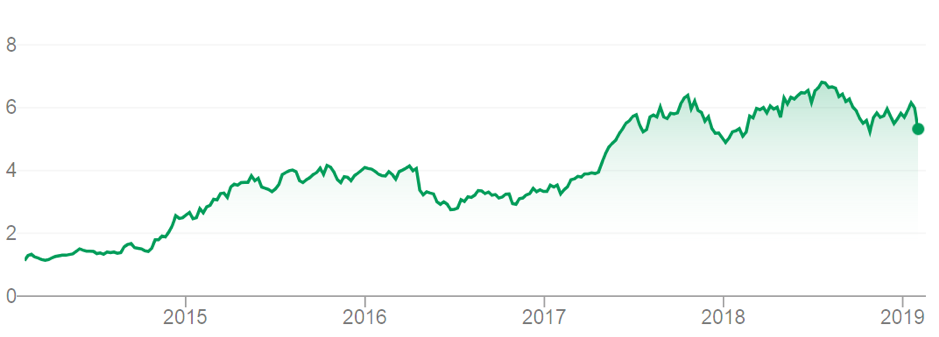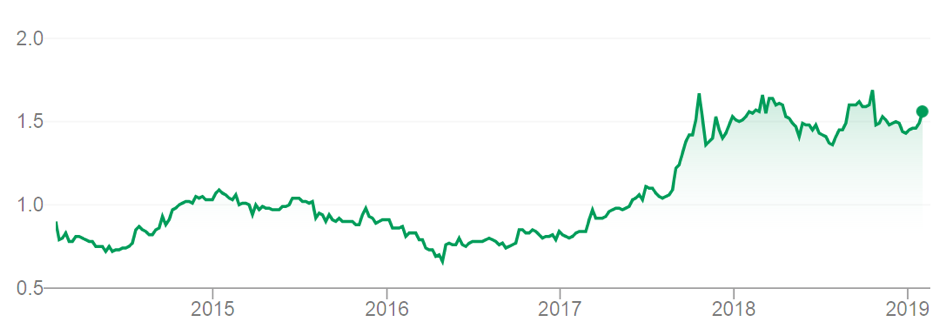Large airline stocks are hard to buy at the best of times. They are capital hungry and affected by the oil price, weather, intense global competition, price discounting, business-travel cyclicality, safety and terrorism risks.
US investment legend Warren Buffett once described airlines as the “worst kind of business” because they need high fixed investment and deliver low profit margins. But even he became bullish on the sector in 2017, when Berkshire Hathaway Inc bought into three US airlines.
Qantas Airways defied the airline bears when it rallied in 2017 and the first half of 2018. Its gains were deserved: Qantas’s Return on Equity (ROE) has improved from barely positive a decade ago to 26% at the end of FY18 – an excellent result, especially for an airline.
CEO Alan Joyce, one of Australia’s best business leaders, has led the airline’s transformation. Also, the airline’s Frequent Flyer programme, once touted as a multi-billion-dollar spin-off, showed the latent value in Qantas and its potential to become a technology business of sorts.
I became bullish on Qantas in June 2016 at $3 a share, writing for this Report: “On some valuation metrics, Qantas is one of the world’s cheapest large-cap airline stocks”. Qantas hit a 52-week high of $6.92 in 2018, buoyed by better passenger volumes and margins.
After that rally, I became bearish on valuation grounds and nominated Qantas in January 2019 as a stock to sell.
I wrote in this Report: “Qantas has had many tailwinds in the past two years: an international and domestic tourism boom, good consumer confidence, lower fuel prices and weak competition. It capitalised on these conditions superbly, but its peak may have passed for now. Qantas would look a lot more interesting below $5 and might get there in a hurry.”
Qantas has fallen from about $6 at that Report to $5.40. From a charting perspective, the stock needs to hold above $5 – a point of previous support. If Qantas breaks that level, the next price-support point is $4. Having quadrupled over four years, the stock is ripe for a bigger pullback.
The market disagrees. An average price target of $7.08, based on the consensus of eight broking firms, suggests Qantas is materially undervalued. Valuation service ShareAnalysis.com values the airline at $7.97 at the end of FY19, rising to $9.22 a year later and $10.20 in FY21.
Either the market has it wildly wrong on Qantas at the current price or broker valuations are too optimistic. I favour the latter. A slowing domestic economy, falling house prices and struggling consumers will weigh on airline passenger volumes and yields. Leisure travel is an easy item to cut when household budgets feel the pinch.
Morningstar’s fair value of $5 for Qantas is more realistic. So, I’ll stick with my earlier view that Qantas would look better below $5 and could have a deeper correction if it breaks that level.
Patient investors should watch and wait for better value. As airlines go, Qantas is a top performer and multi-year trends driving its earnings, such as higher propensity for Australians to travel and the inbound tourism boom, are firmly in place.
Also I still believe the Qantas Loyalty business has fabulous prospects as it expands into health insurance, financial services and other ventures – and that the market does not give the Frequent Flyer programme or the data analytics it provides enough consideration. It’s just too early to buy Qantas.
Chart 1: Qantas Airways

Source: ASX
Alliance Aviation Services
My wary view on airlines over the years has not always extended to smaller operators. I’ve been bullish for a few years on Alliance Aviation Services, a small-cap Queensland airline that services the mining sector and its army of fly-in, fly-out workers.
To recap, Alliance listed on the ASX through an Initial Public Offering (IPO) at $1.60 a share, soared to $2.30 within six months, then tanked to 41 cents during the mining downturn in 2014. The market forgot about Alliance for a few years, as airline demand from mining companies eased.
I nominated Alliance for this Report in February 2018 at $1.71 and again at $2.45 in October. The airline had rising earnings growth, falling debt, fleet investment and better product diversification. And was leveraged to a recovery in mining-services activity.
Alliance is trading near its record high of $2.59, having delivered a total return (including dividends) of 49% over 12 months.
The big news was Qantas announcing a 19.9% stake ($60 million) in Alliance this month. The market expects Qantas will build a majority stake in Alliance but the latter’s board says it has not received any takeover approach.
Either way, Qantas’s interest in Alliance validates the small airline’s prospects and performance – and the long-term outlook for regional aviation. There is some talk that Virgin Australia Holdings could take a stake in Alliance to protect its tie-up with the company on some regional routes, possibly creating a bidding war with Qantas for control.
Alliance is clearly in play. Qantas signalling its interest in building majority control in Alliance suggests underlying buying support for the stock. There’s nothing better than a fight between duopolists for a small company.
After recent price gains, Alliance is due for a pause or pullback, but remains one of the market’s more interesting small caps. It suits experienced, risk-tolerant investors who understand the challenges of holding potentially volatile stocks.
Chart 2: Alliance Aviation Services

Source: ASX
Regional Express Holdings
The market’s other small airline, Regional Express Holdings (REX), had a small bounce in early February on the Alliance takeover speculation. Rex has had a disappointing 12 months (the total return is minus 1%), despite good growth in pre-tax profit in FY18.
At its Annual General Meeting, Rex noted falling profits in other airlines because of higher fuel costs, a world-wide pilot shortage and aggressive price discounting. With drought hurting air-travel demand in regional Australian centres, Rex has many challenges.
I wrote favourably about Rex for this Report in 2014 at $1.09 a share (it now trades at $1.55) but have preferred Alliance, given its exposure to mining activity. Rex is a well-run small-cap company but offers less leverage to fly-in, fly-out workers compared to Alliance.
I’m becoming more bullish on Rex as its operational performance improves and after Qantas’s emergence on the Alliance Aviation share register. Lower fuel costs would boost Rex and better agriculture conditions (thanks to much-needed rainfall up north) and continued growth in mining activity should stimulate higher air-travel demand in regional centres.
My guess is the big airlines will look closer at Rex now that Qantas has shown its hand with Alliance and its view on regional airline exposure.
Rex would be a neat bolt-on acquisition for a big airline and looks reasonable value with or without a takeover. Like Alliance, it suits experienced investors who can tolerate risk.
Chart 3: Regional Express Holdings

Source: ASX
Tony Featherstone is a former managing editor of BRW, Shares and Personal Investor magazines. The information in this article should not be considered personal advice. It has been prepared without considering your objectives, financial situation or needs. Before acting on information in this article consider its appropriateness and accuracy, regarding your objectives, financial situation and needs. Do further research of your own and/or seek personal financial advice from a licensed adviser before making any financial or investment decisions based on this article. All prices and analysis at 6 February, 2019.

